
Este EarthCaché fue creado especialmente para celebrar el 10º cumpleaños del programa de EarthCache.

Ammonite muy preciosa!
Para registrar este EarthCaché como encontrado, debe visitar el lugar de las coordenadas publicadas (se necesita un dispositivo de medición, como una regla o una cinta métrica), y enviar un email al propietario del EarthCaché (enderezo publicado en el perfil público en el sitio www.geocaching.com) con las respuestas correctas a las siguientes preguntas:
1 - ¿Cuál es el diámetro del fósil de ammonite?
2 - ¿Cuál es la profundidad máxima del fósil de ammonite?
3 - Después de observar el fósil de ammonite determinar: ¿cuál fue el período de la era Mesozoica (Triásico, Jurásico o Cretácico) en que se formó la roca huésped?
Puede hacer el registro de encontrado después de enviar sus respuestas
No es necesario esperar a la autorización del propietario para hacer el registro de encontrado.
Si las respuestas no se presentan o son incorrectos, se borrará tu registro de encontrado.
Introducción
El uso moderno de la palabra "fósil" se refiere a la evidencia física de la vida anterior de un período de tiempo anterior a la historia humana registrada.
Esta evidencia prehistórica incluye los restos fosilizados de organismos vivos, las impresiones y moldes de su forma física, y las marcas o huellas creadas en el sedimento por parte de sus actividades.
No hay una edad universalmente aceptada en la que la evidencia puede ser denominada fosilizada, sin embargo es ampliamente entendido que abarca algo más que unos pocos miles de años.
Esta definición incluye nuestra ascendencia humana prehistórica y la fauna de la edad de hielo (por ejemplo, mamuts), así como los más antiguos grupos de fósiles, como los dinosaurios, ammonites y trilobites. En general, se piensa en un fósil como algo vivo que se ha convertido en piedra. Sin embargo, un fósil también puede ser una impresión.
Los fósiles son nuestra mejor forma de evidencia acerca de la historia de la vida en la Tierra. Además, los fósiles nos pueden dar pistas sobre los climas del pasado, los movimientos de las placas, y otros eventos geológicos importantes.
El primer indicio que los fósiles pueden dar es, si el entorno fuera marino (bajo el agua) o terrestre (en la tierra). Junto con las características de las rocas, fósiles pueden indicar si el agua era superficial o profunda, y si la tasa de sedimentación era lenta o rápida. La cantidad de desgaste y fragmentación de un fósil puede permitir a los científicos estimar la cantidad de acción de las olas o de la frecuencia de las tormentas.
A menudo, los fósiles de organismos marinos se encuentran en o cerca de las montañas altas. Por ejemplo, el Himalaya, las montañas más altas del mundo, contienen trilobites, braquiópodos y otros fósiles marinos. Esto indica que las rocas en el fondo del mar se han levantado para formar enormes montañas. En el caso de la cordillera del Himalaya, esto ocurrió cuando el subcontinente indio empezó a chocar en Asia hace unos 40 millones de años.
¿Qué vas a encontrar en este sitio?
En este sitio encontrarás un hermoso molde de ammonite fosilizado. No hay ammonite en este lugar, sólo el molde de la concha. Un fósil de molde es una marca hecha en los sedimentos por las partes duras de un organismo.
Ammonites son un grupo extinto de animales invertebrados marinos, perteneciendo a la subclase Ammonoidea y clase Cephalopoda. Ammonites eran cefalópodos, predadores que se movían rápidamente y moluscos que nadaban libremente por los antiguos océanos. Vivieran en la misma época en que dinosaurios caminaban por la Tierra y desaparecieron durante el mismo evento de extinción (hace 65 millones de años).
Estos animales marinos estaban protegidos por una concha dura (generalmente en espiral) a base de calcio que contenía muchas cámaras llenas de aire; el animal vivía sólo en la cámara exterior. Las conchas iban desde gruesas a delgadas, amplias o estrechas, suaves o muy adornadas. Las paredes de cada cámara son llamadas septos; estos muros fueron penetrados por una estructura en forma de tubo ventral llamado sifón que probablemente regula la presión del aire, así lo permite al ammonite fluctuar.
Existe una vasta gama de tamaños, desde pequeñas especies con sólo un par de centímetros de diámetro, a los grandes que alcanzan casi dos metros de diámetro.
Los científicos usan las distintas formas y tamaños de conchas de ammonites que aparecen y desaparecen por entre los siglos para datar otros fósiles y rocas.
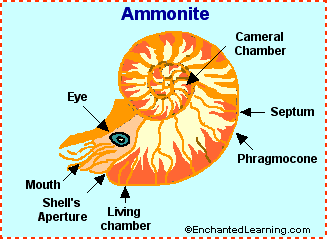
Evolución de los ammonites
Durante la evolución de ammonites ocurrieron tres eventos catastróficos. La primera durante el período Pérmico (hace 250 millones de años), sólo el 10% sobrevivió. Florecieron durante todo el período Triásico, pero al final de este período (hace 206 millones de años) todos menos una especie murieron. Entonces empezaron a prosperar a partir del período Jurásico hasta el final del período Cretácico, cuando todas las especies de ammonites se extinguieron. Cada especie se caracteriza generalmente por una gran expansión que duró sólo un breve tiempo.
Para los paleontólogos, la importancia de ammonites se debe sobre todo al hecho de que se utilicen de una manera especial como fósiles índice. Son excelentes fósiles guía, y con frecuencia es posible vincular la capa de roca en la que se encuentran para períodos específicos de tiempo geológicas.
Tipos y características de ammonites
Hay muchos tipos diferentes de ammonites, algunos redondeados, otros aplanados, algunos duros, otros suaves. Las secciones son diferentes también y algunas encajan entre sí con una línea recta, otras con una línea curva.
Se pueden distinguir Ammonites (subclase Ammonoidea) por sus septos (divisorias que separan las cámaras en el phragmocone) y por la naturaleza de sus suturas donde la divisoria alcanza la pared exterior. Septos ammonoides característicamente tienen protuberancias y hendiduras y pueden ser convexos en deferentes grados, distinguiéndolos de los septos nautiloid que son típicamente estructuras en forma de platos cóncavos simples. La topología de los septos, especialmente alrededor de la llanta, resulta de los diferentes patrones de sutura que pueden existir. Patrones de sutura son muy útiles para distinguir las diferentes especies de ammonites. Existen tres tipos principales de patrones de sutura de Ammonoidea que nos permiten definir a qué período de tiempo, el ammonite pertenece:
Goniatitic - Numerosos lóbulos indivisos y sillas; típicamente 8 lóbulos alrededor de la caracola. Este patrón es característico de los ammonites del Paleozoico;
Ceratitic - Lóbulos han subdividido consejos, dándoles una apariencia de dientes de sierra, y redondeado sillas indivisas. Este patrón de sutura es característico de ammonites Triásico;
Ammonitic - Lóbulos y sillas están muy subdivididos (estriado); subdivisiones son generalmente redondeadas en lugar de dientes de sierra. Este tipo de sutura es característico de ammonites del Jurásico y Cretácico.
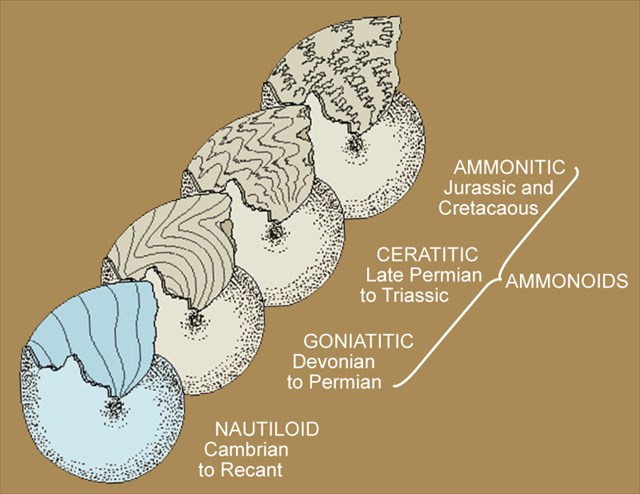
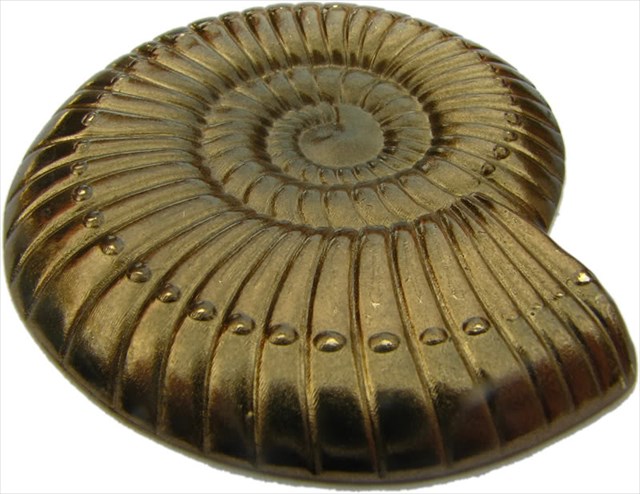
 Triásico Tardío
Triásico Tardío 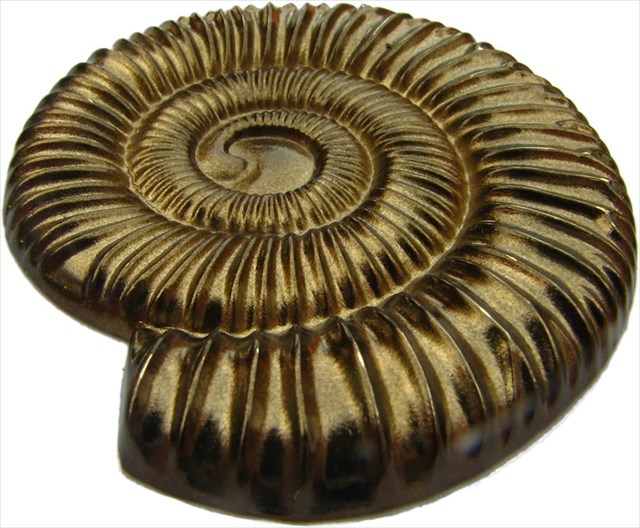
 Jurásico Temprano
Jurásico Temprano

 Jurásico Tardío
Jurásico Tardío 
 Cretácico Tardío
Cretácico Tardío
¿Qué se puede aprender de este EarthCaché?
Fósiles de Index
Fósiles de Index (también conocidos como fósiles guías, fósiles indicadores o fósiles de la zona) son fósiles utilizados para definir e identificar los períodos geológicos (o etapas de fauna). Fósiles de index ayudan geólogos a encontrar la edad relativa de una capa de roca y hacerlo coincidir con otras capas de roca.
Ellos trabajan en la premisa de que, aunque los diferentes sedimentos pueden parecer diferentes dependiendo de las condiciones bajo las cuales fueron establecidas, pueden incluir los restos de la misma especie de fósil. Si la especie en cuestión fuera de corta duración (en términos geológicos, que dura unos cientos de miles de años), entonces es seguro que los sedimentos en cuestión fueron depositados dentro de ese período de tiempo limitado. Cuanto más corto es el tiempo de vida de una especie, más precisamente los sedimentos diferentes se pueden correlacionar, y así la rápida evolución de los tipos de fósiles es especialmente valiosa.
Los mejores fósiles guía son comunes, fáciles de identificar a nivel de especie, y tienen una amplia distribución - de lo contrario la posibilidad de encontrar y reconocer uno de los dos sedimentos es menor. Amonittes encajan estas demandas también, y son los fósiles más conocidos que han sido ampliamente utilizados como fósiles de index.
En la siguiente figura donde fuera introducida una escala de tiempo relativa, son ejemplos de fósiles Index, las formas de vida que existieron durante períodos limitados de tiempo geológico y por lo tanto se utilizan como guías para la edad de las rocas en las que se conservan:
Ammonites son excelentes fósiles de index, y con frecuencia es posible vincular la capa de roca en la que se encuentran con los períodos geológicos específicos. Debido a su rápida evolución y distribución de amplia difusión (que se encuentra en todos los continentes) que son una excelente herramienta para la indexación de citas y rocas.
Amonittes eran comunes durante la Era Mesozoica (245 hasta 65 millones de años). No se encontraron después del período Cretácico, ya que se extinguieron durante el evento de extinción masiva del Cretácico-Terciario (65 millones de años).
Los Fósiles de Index y la Datación Relativa
Los fósiles son importantes para la elaboración de la edad relativa de las rocas sedimentarias. A lo largo de la historia de la vida, diferentes organismos han aparecido, florecido y se extinguirán. Muchos de estos organismos han dejado sus restos como fósiles en rocas sedimentarias. Los geólogos han estudiado el orden en que los fósiles aparecían y desaparecían a través del tiempo y de las rocas. Este uso del estudio de los fósiles que salen el orden relativo de los estratos de roca se llama bioestratigrafía.
El principio de la sucesión faunística indica que las diferentes especies fósiles siempre aparecen y desaparecen en el mismo orden, y que una vez que una especie fósil se extingue, desaparece y no puede volver a aparecer en rocas más jóvenes. El principio de la sucesión faunística permite a los científicos utilizar los fósiles para entender la edad relativa de las rocas y fósiles. Los fósiles se producen durante un intervalo distinto, de tiempo limitado.
Debido a su rápida evolución y distribución generalizada, ammonites son utilizados por los geólogos y paleontólogos de bioestratigrafía. Así, usando amonoideos ha sido posible dividir el Mesozoico en numerosas "biozonas", cada una de las cuales corresponde a un período de tiempo en el que estuvo presente una o más especies características. Debido a la amplia difusión de los ammonites esas zonas pueden ser correlacionadas a través de amplias áreas con una precisión considerable.
Métodos de datación relativas se utilizan para describir una secuencia de eventos. Estos métodos utilizan los principios de la estratigrafía para colocar los eventos grabados en las rocas de la más antigua hasta la más joven. La datación relativa no proporciona fechas numéricos reales de las rocas.
Los fósiles de índice son herramientas útiles para la comprensión de la edad relativa de las rocas, ya que cada especie fósil refleja un período de tiempo único en la historia de la Tierra. Un examen cuidadoso de los fósiles de ammonites en rocas ayuda a los geólogos a determinar la edad relativa de las rocas que allí se producen.
En la siguiente figura, ese rango de edad distinto para cada especie fósil está indicado por las flechas de color gris que se basa la imagen de cada fósil. La posición de la punta de flecha inferior indica la primera aparición de los fósiles y la punta de flecha superior indica su última ocurrencia - cuando se extinguió. Gracias al uso de los rangos de edad de superposición de múltiples fósiles, es posible determinar la edad relativa de las especies fósiles (es decir, el intervalo relativo de tiempo durante el cual se produjo esa especie de fósiles). Por ejemplo, hay un intervalo de tiempo específico, indicado por la caja de color rosa, en el que co-existían tanto el ammonite azul como el naranja. Si ambos los ammonites azul y naranja se encuentran juntos, la roca debe haber sido depositado durante el intervalo de tiempo indicado por la caja de color rosa, que representa el tiempo durante el cual coexistían ambas especies fósiles. En esta figura, el fósil desconocido, una esponja de color marrón, se produce con otros cinco fósiles del conjunto B. El conjunto fósil B incluye los fósiles guías ammonite naranja y ammonite azul, lo que significa que el conjunto B tiene que haber sido depositado durante el intervalo de tiempo indicado por la caja de color rosa. Ya que el fósil desconocido, la esponja de color marrón, se encontró con los fósiles del conjunto B también debe haber existido durante el intervalo de tiempo indicado por la caja de color rosa.
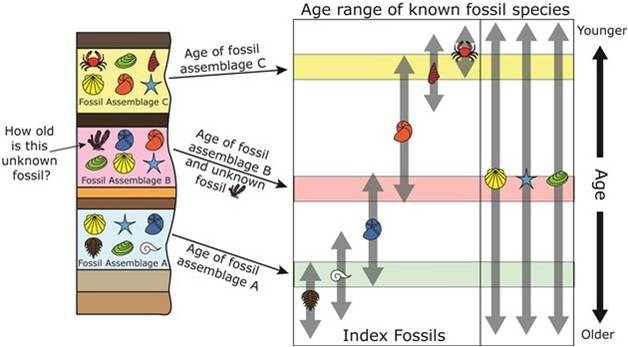
Obviamente, las asociaciones fósiles cambian de un periodo a otro. Ellos siguen una progresión ordenada que es muy clara y predecible. Por lo tanto, podemos utilizar la sucesión de asociaciones fósiles para establecer la edad relativa de las rocas.
Los fósiles pueden ayudar para que coincida con las rocas de la misma edad, incluso cuando te encuentras esas rocas muy distantes. Este proceso de comparación se llama correlación, que ha sido un proceso importante en la construcción de escalas de tiempo geológicas.
En geología, la correlación trata de igualar las rocas o fósiles de la misma edad entre diferentes ubicaciones. La correlación puede involucrar a juego una roca sin fecha con una fecha en otro lugar. Fósiles de index se pueden utilizar para correlacionar la edad relativa de las rocas que están separados por grandes distancias, incluso correlacionar rocas de diferentes continentes.
Fósiles de índice son particularmente útiles para identificar los períodos de la historia geológica y hacer coincidir piezas de estratos de roca que han sido separados por grandes distancias. Cuando uno afloramiento contiene dos fósiles guía a partir de dos diferentes períodos de tiempo, que actúa como un "eslabón perdido" entre otros afloramientos que tienen sólo uno de los dos fósiles. Por ejemplo, ammonites vivieron en la era Mesozoica. Si encuentra ammonites en una roca en la isla del Sur, y también en una roca en la isla del norte, se puede decir que ambos son rocas del Mesozoico. Las diferentes especies de ammonites vivieron en diferentes épocas en el Mesozoico, por lo que la identificación de una especie fósil puede ayudar a reducir, cuando se formó la roca.
Espero que disfruten de esta preciosa ammonite y el increíble paisaje que la rodea.
Feliz EarthCaching!
Términos y Definiciones:
Strata (singular: estrato): distintas capas de sedimentos que se acumularon en la superficie de la tierra.
Estratigrafía: El estudio de los estratos y sus relaciones.
Bioestratigrafía: El uso de los fósiles para elaborar el orden relativo de los estratos de roca.
Principio de horizontalidad original: Las capas de estratos se depositan horizontalmente, o casi horizontalmente, y en paralelo o casi paralelo a la superficie de la tierra.
Principio de superposición: En una secuencia no deformada, las rocas más antiguas se encuentran en la parte inferior y las rocas más jóvenes están en cima.
Fuentes:
http://en.wikipedia.org/wiki/Index_fossils
http://en.wikipedia.org/wiki/Ammonoidea
http://gwydir.demon.co.uk/jo/fossils/ammonite.htm
http://www.discoveringfossils.co.uk/whatisafossil.htm
http://skywalker.cochise.edu/wellerr/students/ammonites/ammonites.htm
http://www.enchantedlearning.com/subjects/dinosaurs/glossary/Ammonite.shtml
http://www.sciencelearn.org.nz/Contexts/Dating-the-Past/Science-Ideas-and-Concepts/Relative-dating
http://www.nature.com/scitable/knowledge/library/dating-rocks-and-fossils-using-geologic-methods-107924044

La manera más excitante de aprender acerca de la Tierra y sus procesos es salir al aire libre y experimentar de primera mano.
Visitar una EarthCaché es una gran actividad al aire libre que toda la familia puede disfrutar.
Una EarthCaché es un lugar especial que la gente puede visitar para aprender acerca de una característica única del aspecto de nuestra Tierra.
EarthCaché se compone de un conjunto de notas educativas y los detalles acerca de dónde encontrar la localización (latitud y longitud).
Los visitantes de una EarthCaché pueden ver cómo nuestro planeta ha sido formado por procesos geológicos, cómo gestionamos los recursos y cómo los científicos reúnen pruebas para aprender sobre la Tierra.
Para saber más: http://www.earthcache.org/
This EarthCache was specially created to celebrate the 10th Birthday of the EarthCache program.
In order to claim the found on this EarthCache, you must visit the place on the published coordinates (you will need a measuring device such as ruler or a tape measure) and send to the email address of the EarthCache owner (published in the public profile on site www.geocaching.com) the correct answers to the following questions:
1 - What is the diameter of the ammonite fossil?
2 - What is the maximum depth of the ammonite fossil?
3 - After observing the ammonite fossil determine which was the period of the Mesozoic era (Triassic, Jurassic or Cretaceous) that the host rock was formed?
After you send the answers, you may submit the found log.
It is not necessary to wait for authorization from the owner to register the found.
If the answers are not submitted or are incorrect, your found log will be deleted.
Introduction
The modern use of the word 'fossil' refers to the physical evidence of former life from a period of time prior to recorded human history.
This prehistoric evidence includes the fossilised remains of living organisms, impressions and moulds of their physical form, and marks or traces created in the sediment by their activities.
There is no universally agreed age at which the evidence can be termed fossilised, however it's broadly understood to encompass anything more than a few thousand years.
Such a definition includes our prehistoric human ancestry and the ice age fauna (e.g. mammoths) as well as more ancient fossil groups such as the dinosaurs, ammonites and trilobites. Usually, you think of a fossil as something living that has been turned to stone. However, you can get a fossil impression.
Fossils are our best form of evidence about the history of life on Earth. In addition, fossils can give us clues about past climates, the motions of plates, and other major geological events.
The first clue that fossils can give is whether an environment was marine (underwater) or terrestrial (on land). Along with the rock characteristics, fossils can indicate whether the water was shallow or deep, and whether the rate of sedimentation was slow or rapid. The amount of wear and fragmentation of a fossil can allow scientists to estimate the amount of wave action or the frequency of storms.
Often fossils of marine organisms are found on or near tall mountains. For example, the Himalayas, the tallest mountains in the world, contain trilobites, brachiopods, and other marine fossils. This indicates that rocks on the seabed have been uplifted to form huge mountains. In the case of the Himalayas, this happened when the Indian Subcontinent began to collide into Asia about 40 million years ago.
What will you find at this site?
At this site you will find a beautiful ammonite mold fossil. There is no ammonite at this place, only the mold of the shell. A mold fossil is a mark made in sediments by the hard parts of an organism.
Ammonites are an extinct group of marine invertebrate animals in the subclass Ammonoidea of the class Cephalopoda. Ammonites were cephalopods, fast-moving predators and free-swimming mollusks of the ancient oceans, living around the same time that the dinosaurs walked the Earth and disappearing during the same extinction event (65 million years ago).
These marine animals were protected by a hard shell (usually spiral-coiled) made from calcium that contained many air filled chambers; the animal lived only in the outer chamber. Shells ranged from thick to thin, from broad to narrow, and from smooth to incredibly ornate. The walls of each chamber are called septa; these walls were penetrated by a ventral tubelike structure called a siphuncle that probably regulated the air pressure, allowing the ammonite to float.
They came in a range of sizes, from tiny species only a couple of centimeters across, to large ones reaching almost two metres in diameter.
Scientists use the various shapes and sizes of ammonite shells that appeared and disappeared through the ages to date other fossils and rocks.
Evolution of Ammonites
During the evolution of ammonites three catastrophic events occurred. The first during the Permian period (250 million years ago), only 10% survived. They went on to flourish throughout the Triassic period, but at the end of this period (206 million years ago) all but one species died. Then they began to thrive from the Jurassic period until the end of the Cretaceous period when all species of ammonites became extinct. Each species is generally characterized by a great expansion that lasted only a brief time.
The importance of ammonoids to paleontologists is due most of all to the fact that they are used in special ways as Index Fossils. They are excellent Index Fossils, and it is often possible to link the rock layer in which they are found to specific geological time periods.
Ammonite Types and characteristics
There are many different types of ammonite, some rounded, some flattened, some ridged, some smooth. The sections are different as well and some fit together with a straight line, some with a wiggley line.
Ammonites (subclass Ammonoidea) can be distinguished by their septa (the dividing walls that separate the chambers in the phragmocone) and by the nature of their sutures where the septa joint the outer shell wall. Ammonoid septa characteristically have bulges and indentations and are to varying degrees convex from the front, distinguishing them from nautiloid septa which are typically simple concave dish-shaped structures. The topology of the septa, especially around the rim, results in the various suture patterns found. Suture patterns are very useful for distinguishing different species of ammonite. Three major types of suture patterns are found in the Ammonoidea and tell us what time period the Ammonite is from:
Goniatitic - Numerous undivided lobes and saddles; typically 8 lobes around the conch. This pattern is characteristic of the Paleozoic ammonoids;
Ceratitic - Lobes have subdivided tips, giving them a saw-toothed appearance, and rounded undivided saddles. This suture pattern is characteristic of Triassic ammonoids;
Ammonitic - Lobes and saddles are much subdivided (fluted); subdivisions are usually rounded instead of saw-toothed. This suture type is characteristic of Jurassic and Cretaceous ammonoids.
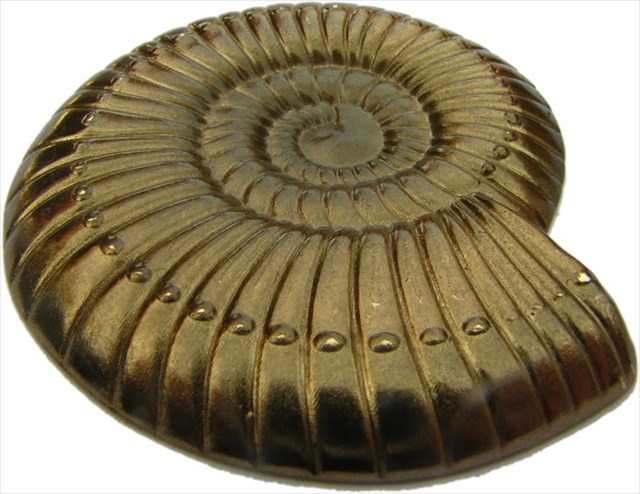
 Late Triassic
Late Triassic 
 Early Jurassic
Early Jurassic

 Late Jurassic
Late Jurassic 
 Late Cretaceous
Late Cretaceous
What can you learn from this EarthCache?
Index Fossils
Index fossils (also known as guide fossils, indicator fossils or zone fossils) are fossils used to define and identify geologic periods (or faunal stages). Index fossils help geologists to find the relative age of a rock layer and match it up with other rock layers.
They work on the premise that, although different sediments may look different depending on the conditions under which they were laid down, they may include the remains of the same species of fossil. If the species concerned were short-lived (in geological terms, lasting a few hundred thousand years), then it is certain that the sediments in question were deposited within that narrow time period. The shorter the lifespan of a species, the more precisely different sediments can be correlated, and so rapidly evolving types of fossils are particularly valuable.
The best index fossils are common, easy-to-identify at species level, and have a broad distribution - otherwise the likelihood of finding and recognizing one in the two sediments is minor. Ammonites fit these demands well, and are the best-known fossils that have been widely used as index fossils.
In the next figure keyed to the relative time scale are examples of index fossils, the forms of life which existed during limited periods of geologic time and thus are used as guides to the age of the rocks in which they are preserved:
Ammonites are excellent index fossils, and it is often possible to link the rock layer in which they are found to specific geological periods. Because of their rapid evolution and wide spread distribution (found on every continent) they are an excellent tool for indexing and dating rocks.
Ammonites were common during the Mesozoic Era (245 to 65 million years). They were not found after the Cretaceous period, as they went extinct during the Cretaceous-Tertiary Mass Extinction event (65 million years).
Index Fossils and Relative Dating
Fossils are important for working out the relative ages of sedimentary rocks. Throughout the history of life, different organisms have appeared, flourished and become extinct. Many of these organisms have left their remains as fossils in sedimentary rocks. Geologists have studied the order in which fossils appeared and disappeared through time and rocks. This study use fossils to work out the relative order of rock strata and is called biostratigraphy.
The principle of faunal succession states that different fossil species always appear and disappear in the same order, and that once a fossil species goes extinct, it disappears and cannot reappear in younger rocks. The principle of faunal succession allows scientists to use the fossils to understand the relative age of rocks and fossils. Fossils occur for a distinct, limited interval of time.
Due to their rapid evolution and widespread distribution, ammonoids are used by geologists and paleontologists for biostratigraphy. Using ammonoids it has thus been possible to divide the Mesozoic into numerous “biozones”, each of which corresponds to a period of time in which was present one or more characteristic species. Because of the ammonoids’ wide diffusion such zones can be correlated across wide areas with a considerable accuracy.
Relative dating methods are used to describe a sequence of events. These methods use the principles of stratigraphy to place events recorded in rocks from oldest to youngest. Relative dating does not provide actual numerical dates for the rocks.
Index Fossils are useful tools for understanding the relative ages of rocks because each fossil species reflects a unique period of time in Earth's history. Careful examination of the ammonite fossils in rocks helps geologists determine the relative ages of the rocks that they occur in.
In the next figure, that distinct age range for each fossil species is indicated by the grey arrows underlying the picture of each fossil. The position of the lower arrowhead indicates the first occurrence of the fossil and the upper arrowhead indicates its last occurrence – when it went extinct. Using the overlapping age ranges of multiple fossils, it is possible to determine the relative age of the fossil species (i.e., the relative interval of time during which that fossil species occurred). For example, there is a specific interval of time, indicated by the pink box, during which both the blue ammonite and orange ammonite co-existed. If both the blue and orange ammonites are found together, the rock must have been deposited during the time interval indicated by the pink box, which represents the time during which both fossil species co-existed. In this figure, the unknown fossil, a brown sponge, occurs with five other fossils in fossil assemblage B. Fossil assemblage B includes the index fossils the orange ammonite and the blue ammonite, meaning that assemblage B must have been deposited during the interval of time indicated by the pink box. Because, the unknown fossil, the brown sponge, was found with the fossils in fossil assemblage B it also must have existed during the interval of time indicated by the pink box.

I hope you enjoy this lovely ammonite and the amazing landscape that surrounds her.
Happy EarthCaching!
Terms & Definitions:
Strata (singular: stratum): Distinct layers of sediment that accumulated at the earth's surface.
Stratigraphy: The study of strata and their relationships.
Biostratigraphy: The use of fossils to work out the relative order of rock strata.
Principle of Original Horizontality: Layers of strata are deposited horizontally, or nearly horizontally, and parallel or nearly parallel to the earth's surface.
Principle of Superposition: In an undeformed sequence, the oldest rocks are at the bottom and the youngest rocks are at the top.
Sources:
http://en.wikipedia.org/wiki/Index_fossils
http://en.wikipedia.org/wiki/Ammonoidea
http://gwydir.demon.co.uk/jo/fossils/ammonite.htm
http://www.discoveringfossils.co.uk/whatisafossil.htm
http://skywalker.cochise.edu/wellerr/students/ammonites/ammonites.htm
http://www.enchantedlearning.com/subjects/dinosaurs/glossary/Ammonite.shtml
http://www.sciencelearn.org.nz/Contexts/Dating-the-Past/Science-Ideas-and-Concepts/Relative-dating
http://www.nature.com/scitable/knowledge/library/dating-rocks-and-fossils-using-geologic-methods-107924044
The most exciting way to learn about the Earth and its processes is to get into the outdoors and experience it first-hand.
Visiting an EarthCache is a great outdoor activity the whole family can enjoy.
An EarthCache is a special place that people can visit to learn about a unique geoscience feature or aspect of our Earth.
EarthCaches include a set of educational notes and the details about where to find the location (latitude and longitude).
Visitors to EarthCaches can see how our planet has been shaped by geological processes, how we manage the resources and how scientists gather evidence to learn about the Earth.